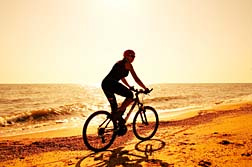 Georgette first got involved with bicycle advocacy and ways to prevent bicycle crashes in Connecticut; she was the executive director of the Connecticut Bicycle Coalition. "Back in the day, Connecticut fueled the American economy in bike making," she says. "In 1905, 1 out of 10 people living in Hartford were employed in bike industry trades. As a lifelong cyclist and someone who has a strong aversion to automobiles, I found it uncanny that I was living in the original bicycle capitol of the world; I thought this place needed to reclaim its legacy.
Georgette first got involved with bicycle advocacy and ways to prevent bicycle crashes in Connecticut; she was the executive director of the Connecticut Bicycle Coalition. "Back in the day, Connecticut fueled the American economy in bike making," she says. "In 1905, 1 out of 10 people living in Hartford were employed in bike industry trades. As a lifelong cyclist and someone who has a strong aversion to automobiles, I found it uncanny that I was living in the original bicycle capitol of the world; I thought this place needed to reclaim its legacy.In 1996 I never even thought of myself as a cyclist; I just wanted to ride my bike. Then I had an epiphany—a bicycle patrol police officer came by my workplace one night and we got to talking about bikes. I complained about how we have a great centennial celebration coming up but nobody was doing anything about promoting the parks. He said I should do something about it so I put together a bike tour and it developed into a full-time position with the Coalition.
We advocated for many inclusion actions for bicycle and transportation planning such as bike racks at all public buildings and on buses, bike lanes on existing roadways, and bike education in public schools. We also had a boys BMX bike team in co-operation with the Hartford police department.
In 2000 I got a job offer to work with the Hawaii Bicycling League so I couldn't turn that down. I wrote a research paper on the history of transportation planning in the state of Hawaii and always felt it was a unique opportunity to live here, but what was my purpose? I soon found out. I lived above the Mamalahoa highway and wondered what it meant. That word was a derivative of 'great law of the land', also known as the 'law of the splintered paddle'. The ancient Mamalahoa king said:
'Oh my people honor my God…see to it that our aged, our women and our children lie down to sleep by the roadside without fear of harm. Disobey and die!'
He was speaking about road safety! Throughout history roadways have been dangerous places, from getting ambushed on the path hundreds of years ago to car and bike crashes today. We have no choice but to make our roads safe because the ancient Hawaiian king decreed it so...
In 2003 I got into law school and wrote a paper titled 'Curbing cars in Hawaii at the intersection of constitutional transportation and environmental law.' I discovered that in 1978 Hawaii had a road safety edict in its constitution but there was a preamble: it was put in as a living symbol rather than incorporating it as substantive, self-executing law. In other words, here we are in paradise and it is a treacherous, hostile environment for cyclists and pedestrians and the law wasn't protecting them. The problem is speed, size and volume; we have a lot of vehicles going really fast and our roadways are a mess—we have a deteriorating infrastructure.
Historically, roadways here weren't resurfaced with removal of the existing tar; instead they just lay down layer over layer of new tar over old. Potholes stay, tar cracks and it is a nightmare for cyclists unless you know the road and can anticipate, listen and use signals. But most of all, you must stay in your bike lane--and there aren't enough lanes.
If you increase the size of a road, you increase the size and number of cars: you don't build your way out of congestion. Rather, you have to enact absolute reductions in the number of automobiles. Hawaii took a look at this concept in 1978 and they came up with a formula to limit cars, boats and planes in the state of Hawaii. Every year for 4 years, the state-wide transportation council got together and came up with an equation to figure out how the state could sustain a certain amount of vehicles at the same time. They looked at it because there was a gas crisis at the time and the size of cars—Buicks were like boats--were a blight on the landscape. But nothing ever got implemented.
READ MORE BIKE CRASH LEGAL NEWS
This is where I come in: I have drafted a bill for consideration called the Sidewalk Equity Bill. Because the condition of our roads is so bad, people are riding on sidewalks. We are having negative interactions between pedestrians and cyclists, particularly with our seniors—there are lots of complaints. But cyclists won't get off the sidewalk until they get room on the road. Now it is time to have this bill passed; Hawaii's main resource is tourism so let's give our visitors a place that is safe. We need to create a transportation infrastructure that promotes walking and biking, not sitting in traffic for hours.
Ride On!"

READER COMMENTS
Ann Marie Manamon
on